Texas is home to a wide range of caterpillars through its warm climate.
The combination of food availability in the form of plants and warm weather makes Texas one of the most hospitable states for caterpillars to grow in.
Texas is home to both native and imported species of caterpillars, many making their way from Mexico and Central America.
Some of the most popular types of caterpillars in North America such as the Monarch caterpillar and the Monarch caterpillar are native to Texas.
Here are the most common species of caterpillars in the Lone Star State.
Table of Contents
1. Monarch Caterpillar
Monarch caterpillars (Danaus plexippus) are highly common in Texas. As they reach their final instar, these caterpillars resemble the striped appearance of adult Monarch butterflies.

Monarch caterpillars have a striped body with yellow, black, and white alternating bands.
These caterpillars go through a total of 5 instars before pupation.
Each instar of the Monarch caterpillar lasts at least 3 days. An instar of this species can even last 5 days in cold weather.
The caterpillar is known to eat the leaves of milkweeds it grows on.
It begins feeding in its first instar, mainly through circular motion. It then changes these feeding pattering to a more perpendicular approach as it reaches its final instar.
The caterpillar then pupates into orange or brown butterflies changing its coloring once more.
2. Gulf Fritillary Caterpillar
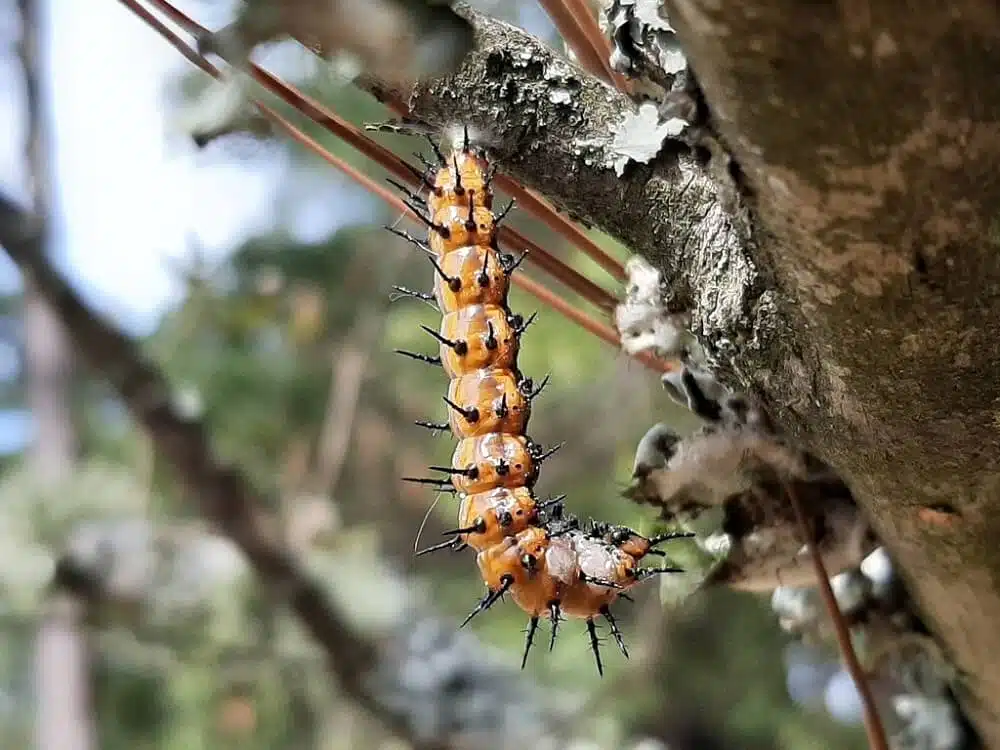
These types of caterpillars (Dione vanilla) are orange with black spines. Highly common in Texas, these caterpillars spend at least 11 days in their larval stages.
In some cases, caterpillars of the genus can spend up to 16 days in the larval stage.
In the meantime, they grow and feed on various passionflower leaves or passion vines, as these flowers are known in Texas.
The damage to these leaves of the species is considered minimal.
Caterpillars of this genus mainly feed on the edges of the leaves, which may even allow some of the affected leaves to survive past their pupation day.
Passionflowers are chosen for their thick leaves which offer good nutrition and protection. These perennial flowers are also common in the state.
3. Queen Caterpillar

Queen caterpillars (Danaus gilippus) are often confused with Monarch caterpillars. Both have a striped body.
The main differences between these species come in colors. Monarch caterpillars are more colorful than Queen caterpillars.
The yellow bands of the species can also help distinguish them further,
Monarch caterpillars have full yellow bands while Queen caterpillars have interrupted bands or just a few yellow dots instead of full bands.
Unlike the Monarch caterpillar which goes through 5 instars, the Queen caterpillar goes through 6 instars.
It eats plants in the process.
The queen caterpillar is also known for storing toxins within its body.
One of the reasons it does it is to have bad taste. This makes it one protected species as almost all predators know it tastes bad.
The larval stage of the Queen caterpillar is also shorter than the larval stage of the Monarch caterpillar.
A Queen caterpillar can pupate within 7 days.
4. Pipevine Swallowtail Caterpillar

Growing on pipevine, Swallowtail caterpillars (Battus philenor) are some of the smallest even in their last instar.
These caterpillars grow to a size of up to 50mm. They are dark brown with red spots and long brown setae.
Pipevine Swallowtails caterpillars only emerge in very hot weather. As a result, they are most common in Texas and Arizona.
You can identify the future caterpillars by the coloring of the eggs on the pipevine.
Swallowtail caterpillar first appears as red eggs on the leaves and stems of pipevine.
5. Gray Hairstreak Caterpillar

Gray Hairstreak caterpillars (Strymon melinus) have a wide distribution across the US. These caterpillars are common in almost every state.
A high prevalence of the species is common in the Eastern US states.
These caterpillars are present in all habitats but not at high altitudes.
Known for a green or translucent green color, the caterpillar is found on almost any host plant.
In most cases, the caterpillar has a preference for mallow and pea plants.
It feeds on the leaves of these plants as well as on the flower buds and small fruits it can find.
6. Common Buckeye Caterpillar
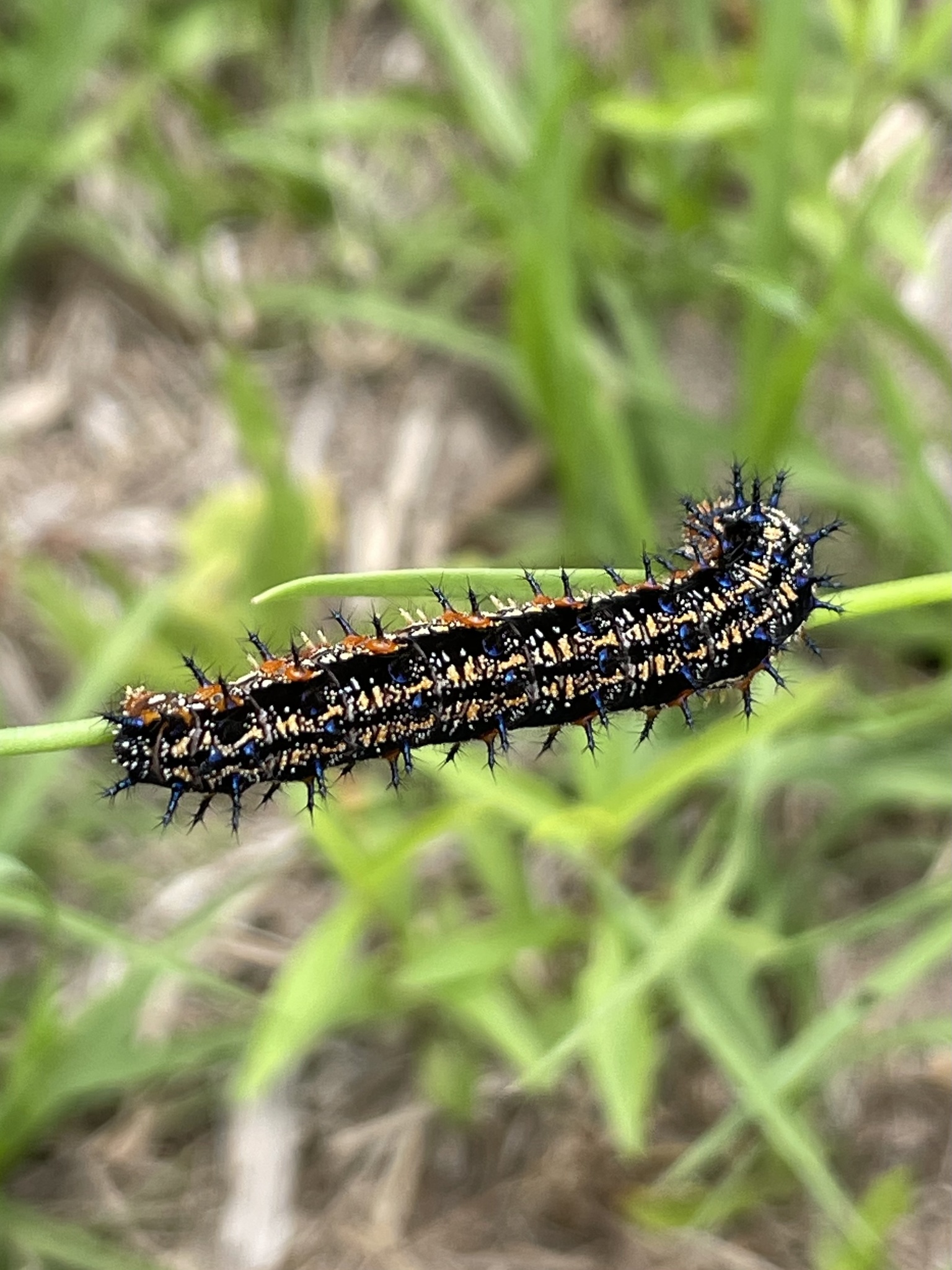
The Common Buckeye caterpillar (Junonia coenia) has a widespread presence in Texas.
Found in multiple counties, this is a species closely associated with the plantain it feeds on.
The species has very complex coloring and 2 setae on each segment.
Black is the dominant color albeit it can vary to brown.
White lateral bands are seen on these caterpillars. Small red circles are also seen on its sides.
Adult butterflies of this genus maintain some resemblance with the caterpillars, mainly through the round eyespots which migrate from the lateral sides of the caterpillar to the hindwings of the adult butterfly.
7. Fiery Skipper Caterpillar
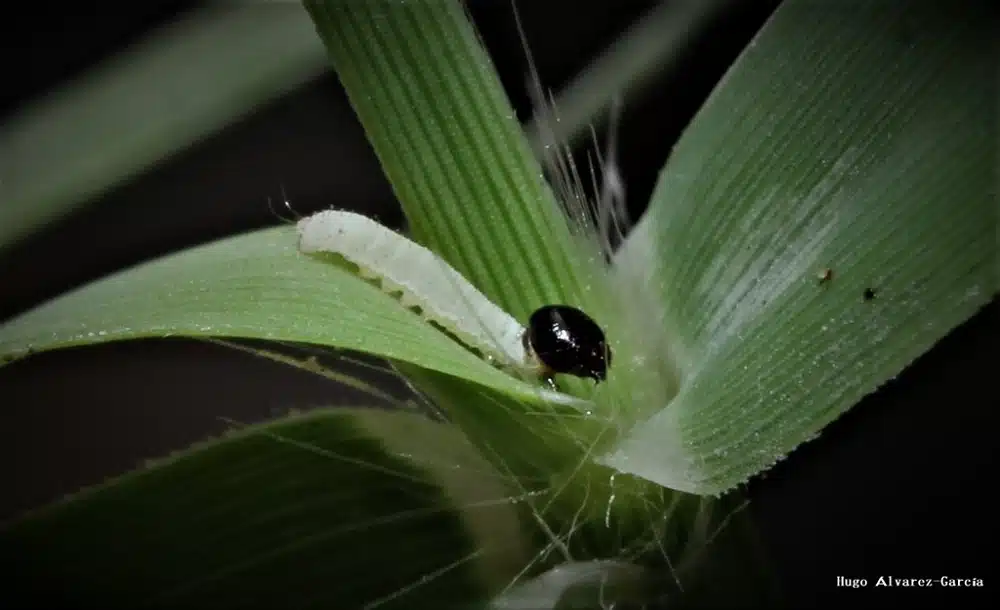
The Fiery Skipper caterpillar (Hylephila phyleus) first emerges as green and then turns brown.
Fiery Skipper caterpillars are a major pest of various types of grass. It feeds on St. Augustine grass and other types of turf grass.
As a result, it hurts lawns and gardens.
The biggest problem with Fiery Skipper caterpillars and their impact on grass is their completely destructive habits.
They feed on entire grass stems and grass roots.
Bald grass patches are the direct result of their complete feeding habits.
8. Red Admiral Caterpillar

Red Admiral caterpillars (Vanessa atalanta) are highly common on various types of nettle around Texas.
This species has a preference for nettle as it’s rarely seen on other types of plants or flowers.
The coloring of the caterpillar changes with the instar.
Red Admiral caterpillars first appear black. This color is maintained up to the final instar when it brightens slightly to a brown color with white spots.
It takes at least 6 days for Red Admiral caterpillars to go through all instars.
This is based on the availability of warm weather as colder weather can double the time the species remains a caterpillar.
It can take up to 14 days for this species to reach its final instar in colder weather.
Early tests on the species also reveal the color of the caterpillar is also affected by the weather. Some caterpillars in cold weather might also exhibit red spots or stripes.
9. Black Swallowtail Caterpillar
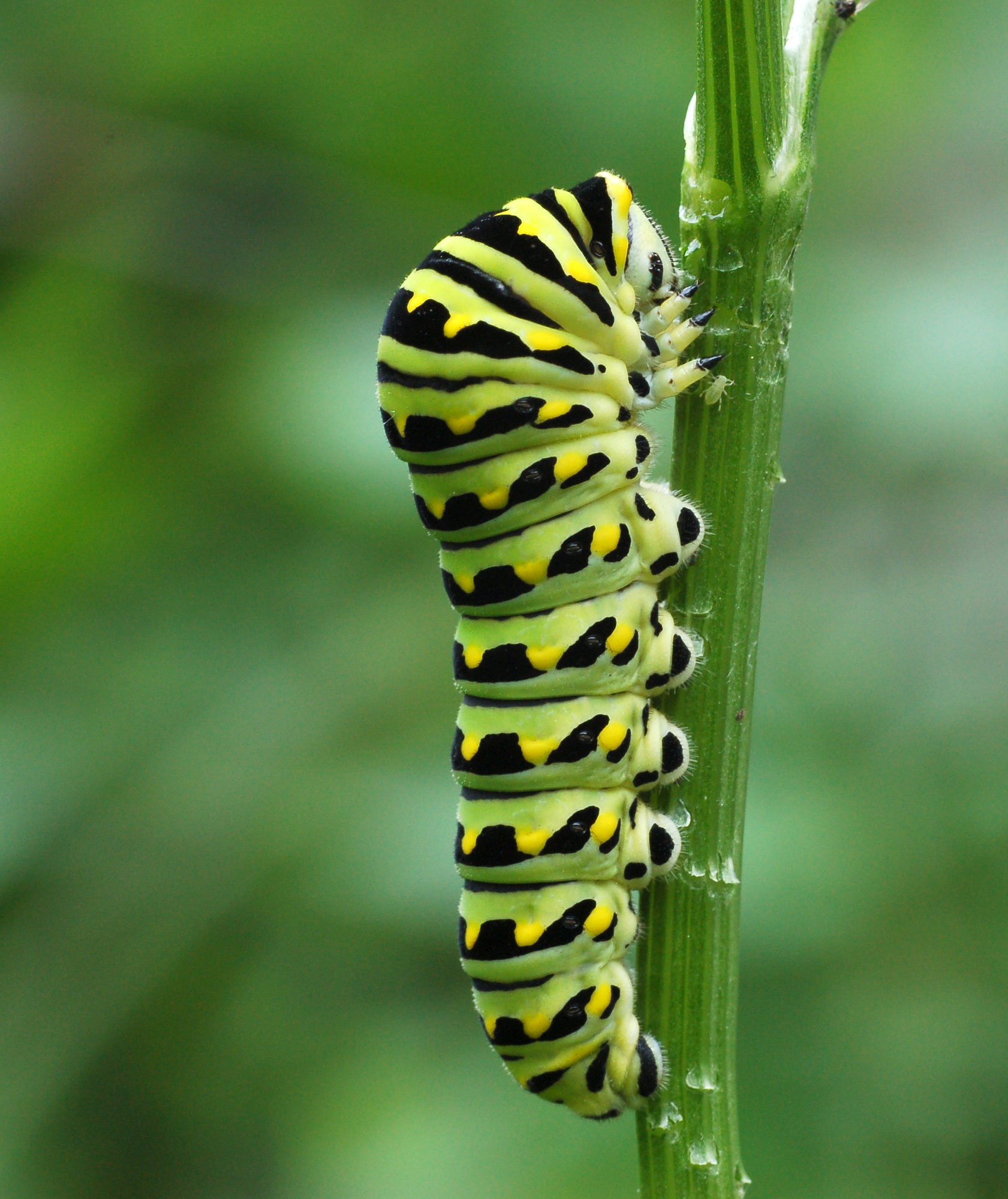
Also known as the Parsley worm, the Black Swallowtail caterpillar (Papilio polyxenes) is a common parsley pest.
This caterpillar can adapt its color to the host plant it lives and feeds on.
Green and black are the main colors of the caterpillar.
Its’ green morph has black lines with yellow dots.
The black morph of the species has white lines and yellow dots.
All of these dots aim to make the species appear poisonous. While not venomous, the Black Swallowtail caterpillar absorbs toxins from all the plants it eats.
This makes it have a bad taste.
Some of these defensive traits are then further transmitted to the adults.
For example, the female Black Swallowtail caterpillar has a color that mimics its environment to escape predators.
10. Variegated Fritillary Caterpillar

Variegated Fritillary caterpillars (Euptoieta claudia) are among the few species that feed on violets.
These caterpillars are mostly black. Red and white stripes are common on the dorsal side.
Variegated Fritillary caterpillars also have a few black spines.
There’s a total of 6 rows of black spines on the species with a deterring role to predators.
As it moves into adulthood, this species then prefers clover and alfalfa fields.
11. Salt Marsh Moth Caterpillar

Salt Marsh Moth caterpillars (Estigmene acrea) are some of the most atypical species in Texas.
Caterpillars of this genus feed on a range of plants and even travel in groups from one plant to another.
Salt Marsh Moth caterpillars are also known for having distinct defensive techniques.
They drop on the ground when disturbed and spin silk which allows them to be carried away by the wind.
While these caterpillars can eat specific flowers, their rare capacity to travel is what opens up new diet possibilities for the species.
As a result, the Salt Marsh Moth caterpillar is among the few Texas species that travel for food.
12. Pearl Crescent Caterpillar

The Pearl Crescent caterpillar (Phyciodes tharos) has a brown body with white dots.
Common in the Eastern half of the United States, the Pearl Crescent caterpillar grows and eats various species of asters.
The caterpillar then goes through a complete metamorphosis. Adult Pearl Crescents have a black and orange body.
Leaves of asters are then swapped for nectar when it comes to food preferences.
13. American Snout Caterpillar

The American Snout caterpillar (Libytheana carinenta) is identified by its uniform green color with yellow dots and lateral yellow stripes.
The species eats sugarberry.
American Snout caterpillars don’t look similar to adult butterflies which are mostly brown.
This species is common in many parts of the US, including Texas and California.
American Snout caterpillars are slightly smaller than most other caterpillars in Texas. They grow to a maximum size of 1 inch.
14. American Lady Caterpillar

Growing on cudweed, the American Lady caterpillar (Vanessa virginiensis) is one of the Texas species difficult to identify due to its multiple morphs.
The caterpillar can be black or yellow with further colored patterns which also vary in shape and coloring.
Many American Lady caterpillars found in Texas are mostly black.
The colored patterns of the species found in Texas vary considerably, on the other hand.
Caterpillars of the genus come with yellow or white dots. Some of them might also have additional red dots.
These caterpillars also have yellow lines or groups of 3 parallel white stripes.
15. Clouded Skipper Caterpillar
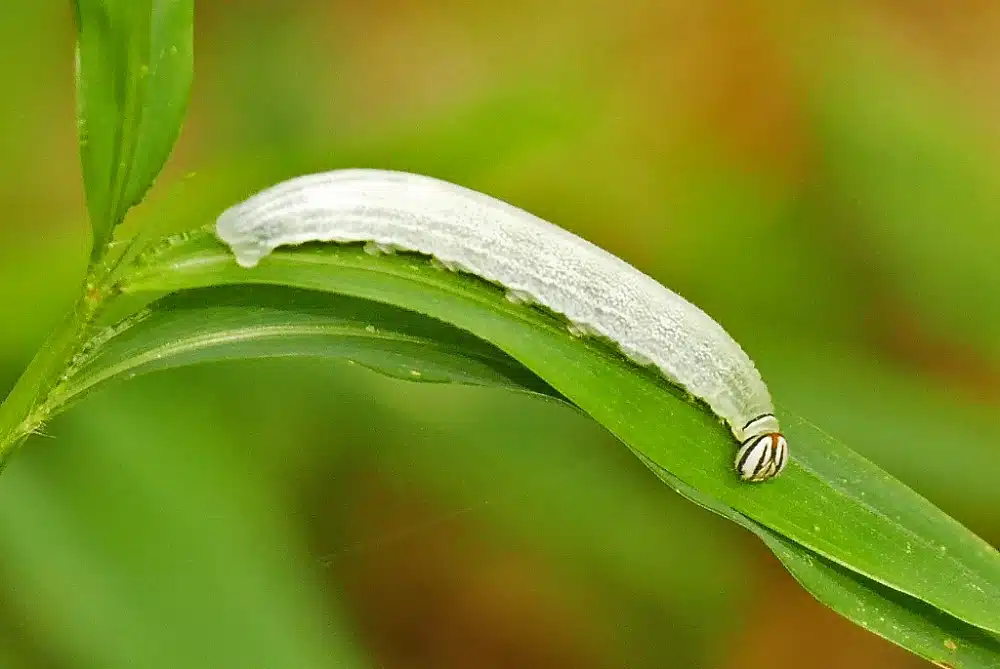
Clouded Skipper caterpillars (Lerema accius) only come in one color. They have a green body without marks or stripes and a brown head.
These caterpillars have a completely different color to the color of adults, which is mostly brown.
Clouded Skipper caterpillars measure up to 1.4 inches and are known to feed on various grasses.
The role of these caterpillars can be significant when it comes to damaging gardens and lawns.
Adults Clouded Skippers change their diet and appearance considerably. Adults are brown and they move on to feeding on nectar, particularly from purple or violet flowers.
Unlike caterpillars, adults are attracted to violet colors.
16. Question Mark Caterpillar
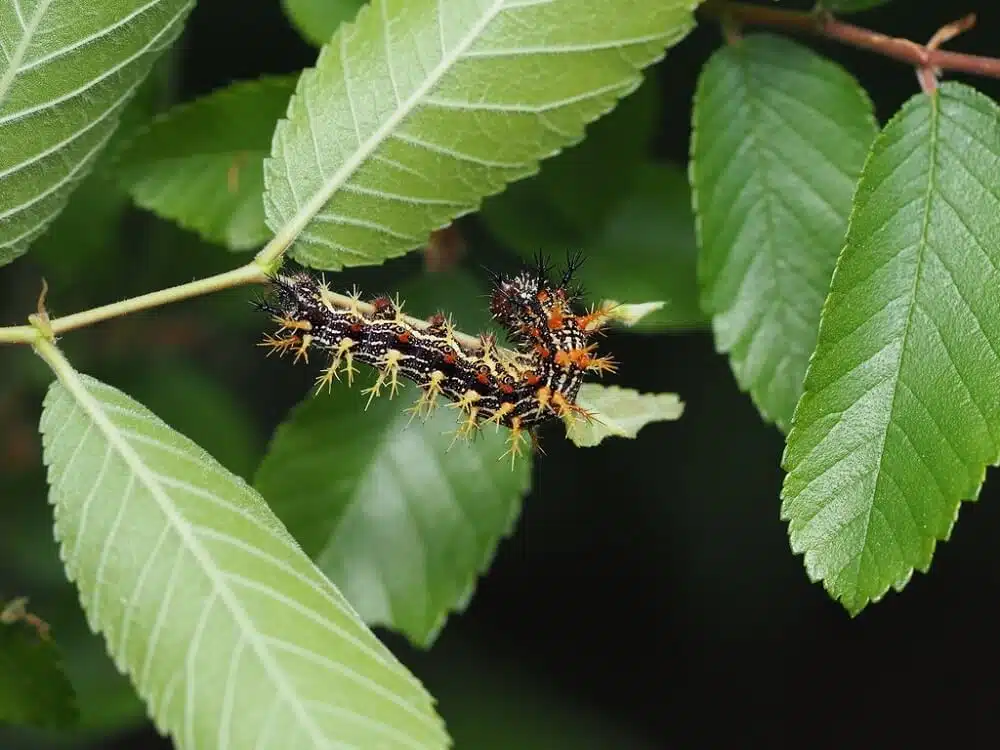
The Question Mark caterpillar (Polygonia interrogationis) has a gray and brown color.
This species is known for growing on various trees such as elm. It feeds on the leaves of these trees, typically without a major impact on the health of the trees.
A reduced population of caterpillars means trees don’t need to die whenever affected by the species.
Question Mark caterpillars should mainly be avoided as adults as they can transmit diseases and bacteria.
Unlike caterpillars and larvae, the Question Mark adult feeds on rotting fruit and even carrion.
17. Tawny Emperor Caterpillar
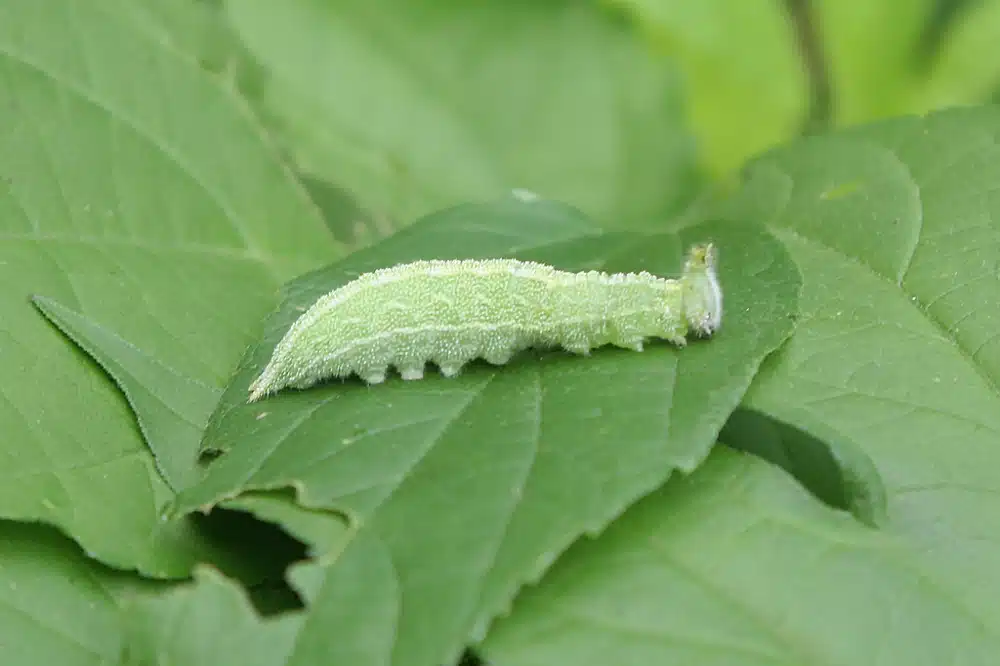
Tawny Emperor caterpillars (Asterocampa clyton) are some of the most damaging types of caterpillars in Texas.
They feed on trees and they multiply in high numbers. This means there’s always a risk for these caterpillars to cause irreversible damage to tree bark and tree leaves.
Southern sugarberries are the trees most affected by this species of caterpillar.
A mature Tawny Emperor caterpillar has a green body with dark green longitudinal stripes, and white and black longitudinal stripes.
The head of the caterpillar is typically black.
Growing to a size of up to 1.5 inches, this is one of the larger species in Texas. Increased sizing and high invasion tendencies make the Tawny Emperor caterpillar a serious economic pest.
18. Hackberry Emperor Caterpillar

Hackberry Emperor caterpillars (Asterocampa celtis) live on hackberries. Caterpillars of the species grow to 1.4 inches before pupation.
These caterpillars have a dark green color.
Small yellow dots are seen all across its body together with fine yellow lines on its sides. The yellow dots makes it appear as a dangerous species that is toxic.
The head is either black or brown.
One of the biggest reasons for concern with Hackberry Emperor caterpillars is the ability of the species to kill trees.
These caterpillars invade trees and eventually leave them dry which means they can die. Economic losses caused by Hackberry Emperor caterpillars are typically mitigated by using pesticides.
19. Orange Sulphur Caterpillar
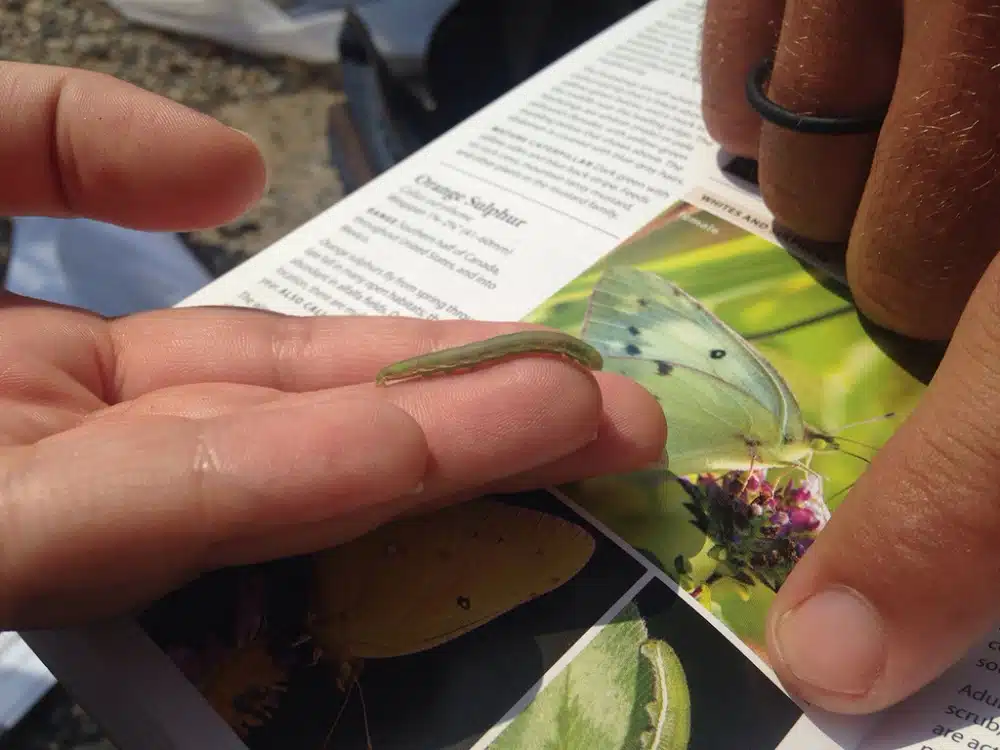
Orange Sulphur caterpillars (Colias eurytheme) are some of the most damaging species found in Texas.
Common on various crops, this caterpillar mainly feeds on various species of peas.
Orange Sulphur caterpillars are a common sight on alfalfa crops.
It can be identified by its green body with yellow stripes. The green body of the species has multiple striations.
There are a few common methods of eliminating the Orange Sulphur caterpillar.
Pesticides are among the proven methods.
Organic farming and non-chemical solutions against Orange Sulphur caterpillars include introducing parasitoid wasps.
20. Bordered Patch Caterpillar

Bordered Patch caterpillars (Chlosyne lacinia) are a common Texas sight. These caterpillars have a bright orange-brown color with dark brown stripes.
The caterpillars feed on sunflowers and can cause economic losses as a result.
Removing the eggs off sunflowers is among the only methods of truly controlling them apart from using deterring chemicals.
Bordered Patch caterpillars aren’t just an economic pest as they also affect other plants and weeds which have no economic benefit.
These caterpillars also feed on ragweed and plants of a similar species.
21. Little Yellow Caterpillar
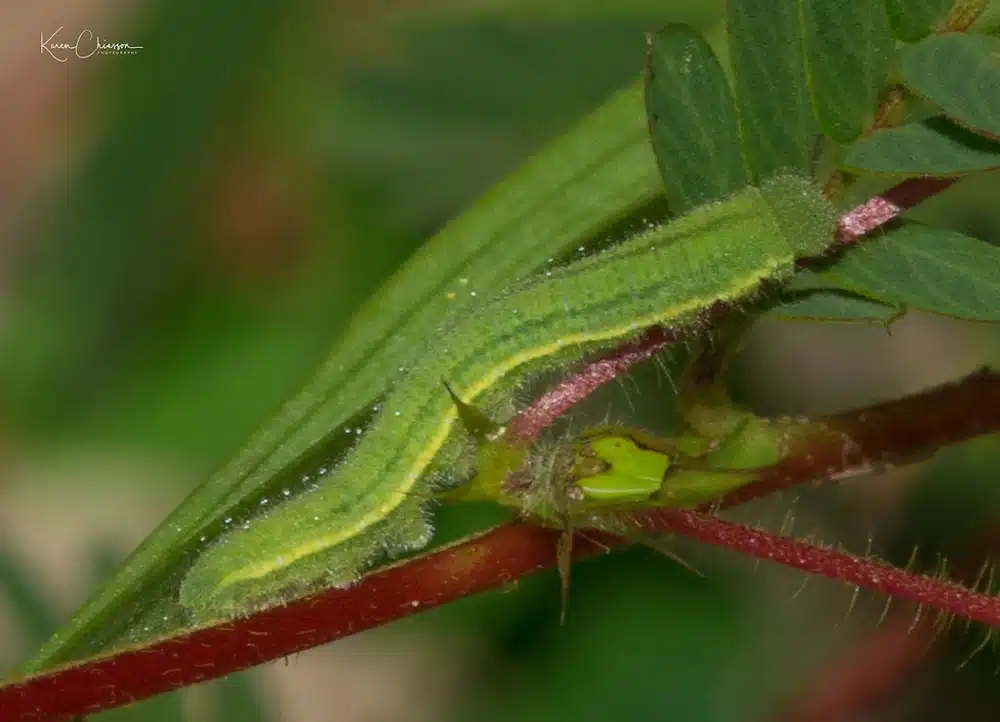
Little Yellow caterpillars (Pyrisitia lisa) are a species of caterpillars of the Little Yellow butterflies.
These caterpillars aren’t yellow as adults. They are green.
The green coloring on the species is light and almost transparent.
The body of the species has little white dots and lateral white lines. Caterpillars of this genus are known to use camouflage for self-defense.
The green coloring of the species makes them blend in with the green pea leaves that live on. These caterpillars also eat the leaves of various pea species.
22. White-lined Sphinx Caterpillar

Common in all regions of Texas, the White-lined Sphinx caterpillar (Hyles lineata) feeds on willow, four-o’clock, and apple tree leaves.
This species doesn’t bite and it’s not known for economic damages.
The White-lined Sphinx caterpillar is green in Texas but yellow Westwards.
Caterpillars of this family are known for having a horn-like structure at the end of the tail.
These caterpillars have a dark green color with yellow and orange spots that have a black border.
Caterpillars of the genus use these colored marks to ward off predators.
These caterpillars can also be yellow. They might have black longitudinal stripes and orange spots in morphs outside Texas.
23. Dainty Sulphur Caterpillar
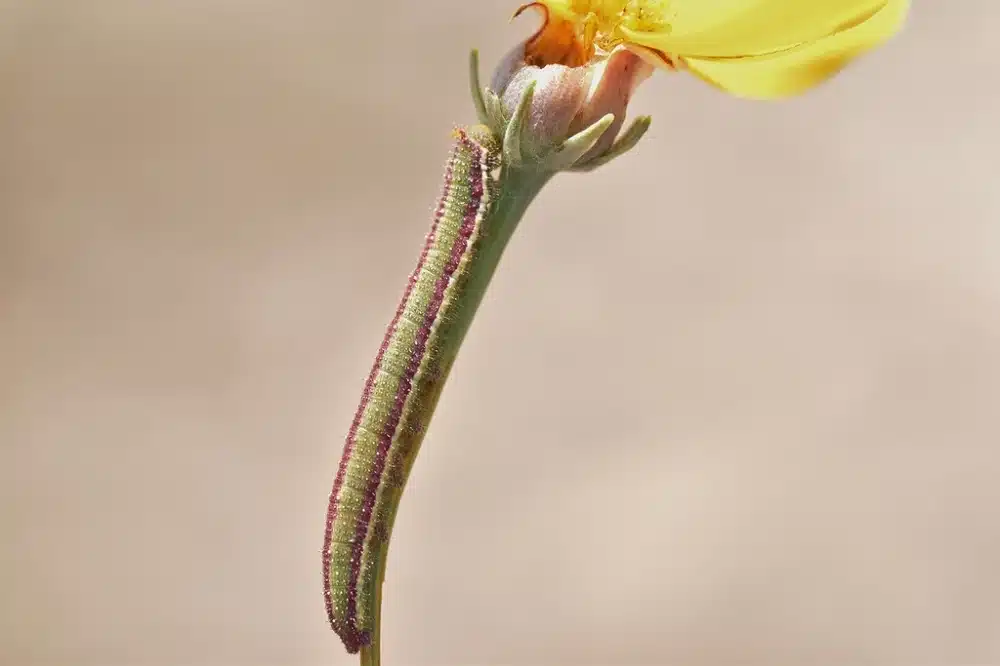
The Dainty Sulphur caterpillar (Nathalis iole) is native to Texas and other US states.
Caterpillars of this genus are mainly green with or without stripes. If the species are striped these stripes are purple.
The purple stripes on the dorsal of the caterpillar are yellow-bordered.
The species mostly feeds on Spanish needles.
24. Eastern Tiger Swallowtail Caterpillar

Eastern Tiger Swallowtails caterpillars (Papilio glaucus) change their colors between instars.
They are first brown and then yellow-brown going into the fourth instar.
One of the reasons for its adaptive color is the mimicry habits of the species. These caterpillars mimic bird droppings which allows them to avoid predation.
Found on many attractive flowers such as magnolias, these caterpillars also have a long list of predators.
They need to maintain camouflage to avoid quick predation, especially since flowers they feed on are also on the diet list of other species.
25. Painted Lady Caterpillar
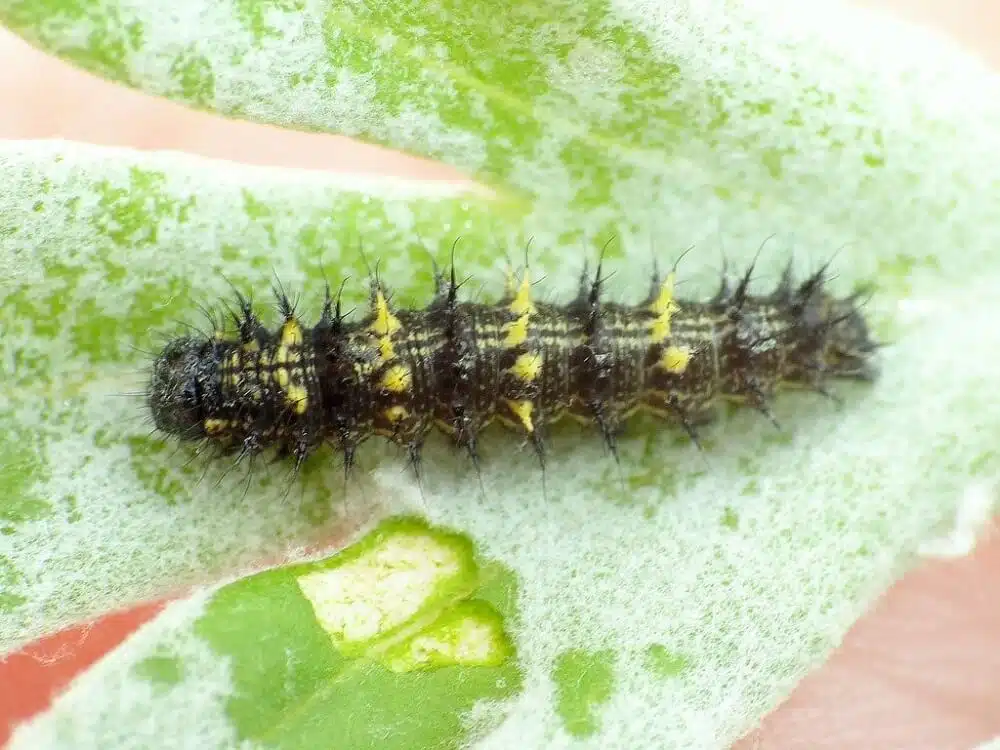
Painted Lady caterpillars (Vanessa cardui) live in silk cocoons to avoid predation.
The species has a gray color with yellow stripes and yellow lines. Its setae are also gray.
Caterpillars of this species are highly common on asters. They prefer to feed on the leaves and flowers of asters.
Adult Painted Lady has a different approach when it comes to feeding.
They feed on nectar and honeydew since both are sweet.
A correlation between aphids and adult Painted Lady butterflies can be made as both can share the same plant.
26. Reakirt’s Blue Caterpillar
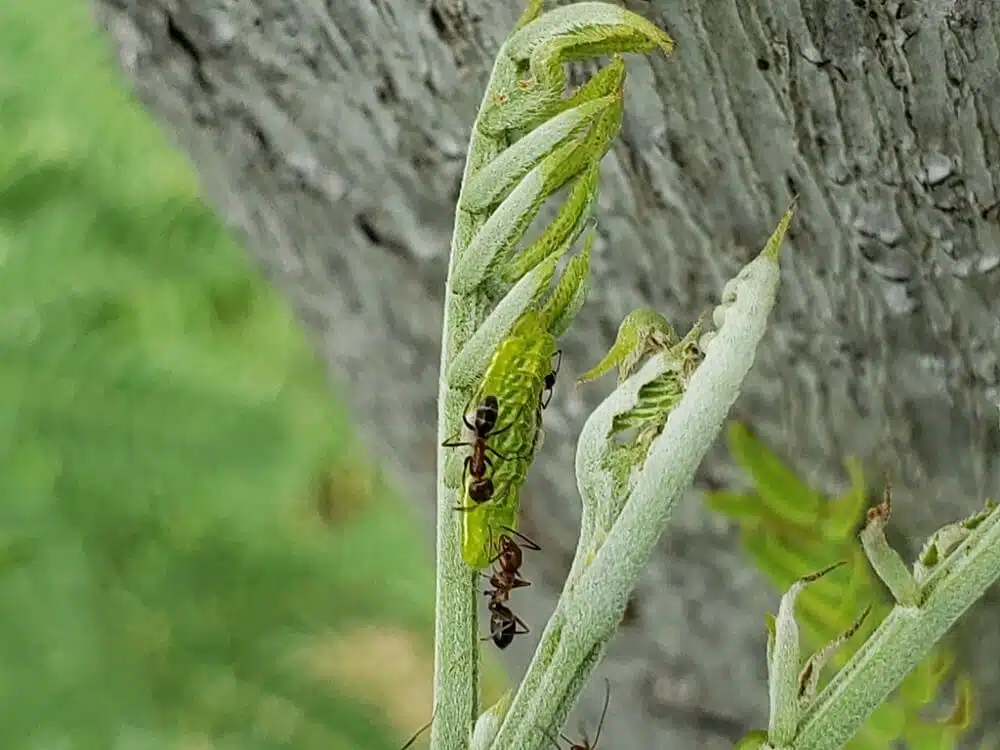
These types of caterpillars (Echinargus isola) live in the driest parts of Texas. They need plenty of warmth, reduced humidity, and the vegetation that grows in such extreme conditions.
While the aren’t many types of trees and flowers living in these areas, these caterpillars feed on mesquite trees which resemble willows.
The foliage of these trees can be completely affected by the caterpillars which leads to poor photosynthesis and stunted growth.
Emerging gray to white adults change their diet to nectar. They feed on various herbs such as spearmint.
27. Forest Tent Caterpillar

Forest Tent Caterpillars (Malacosoma disstria) are known for foraging in groups.
This is one of the rare groups in Texas that only goes out to eat together.
A large number of these caterpillars get moving whenever most caterpillars in the group are hungry.
They can eat almost anything if facing hunger but many groups solely target oak leaves.
Caterpillars of this genus are guided by the desire of the group rather than the desire of the individual. Almost all caterpillars of the group need to be hungry for the group to move on towards food.
28. Green Cloverworm
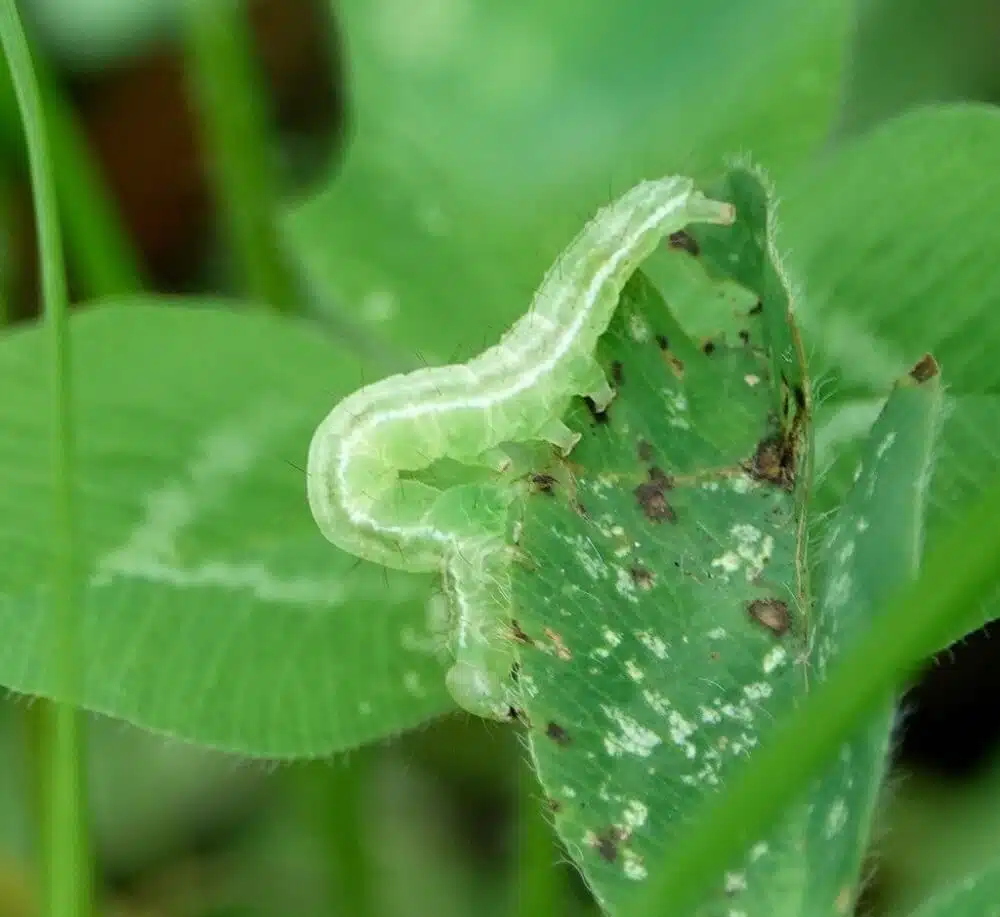
These caterpillars (Hypena scabra) are green and grow to 30mm.
With a long body, they also manifest higher levels of aggression compared to other caterpillars in Texas.
The Green Cloverworm Moth caterpillar almost reached pest status.
It does not impact crops significantly but it can cause significant losses when found on common crops other types of caterpillars are also found.
These common crops might be soy crops. Soy attracts a wide range of pests and Green Cloverworm Moth caterpillars are part of this category that needs to be eliminated.
Insecticides are used against all of these common pests.
29. Sleepy Orange Caterpillar

The Common Partridge Pea is the host plant of the Sleepy Orange caterpillar (Abaeis nicippe) in Texas.
Known for its green color, this plant also looks very similar to the caterpillar itself which is also green.
Like almost all green caterpillars in Texas, the Sleepy Orange caterpillar also has lateral stripes. These thin stripes are always yellow.
30. Cloudless Sulphur Caterpillar

As one of the largest caterpillars in Texas, the Cloudless Sulphur caterpillar (Phoebis sennae) grows to a length of over 50mm.
The species is known to share the same host plant as the Sleepy Orange caterpillar or many other species in Texas. It is the Common Partridge Pea.
Cloudless Sulphur caterpillars change colors depending on their instar. They are mostly green with a wide yellow stripe and small blue dots with black borders.
This color then darkens whole the blue spots turn to green spots.
This caterpillar finally changes its color towards its last instar as well. It turns dominantly yellow with black dorsal stripes and dots. Its colorful appearance deters most of its predators away.
31. Polyphemus Moth Caterpillar

This species of caterpillars (Antheraea polyphemus) go through 5 instars. It eats its eggshell as soon as it hatches as a source of protein.
The Polypyphemus Moth is one of the most interesting species in Texas as adults are known not to eat.
These moths live between 5 and 7 days and they don’t eat since they have very small mouths.
Caterpillars of the species eat and they change colors a few times up to the 5th instar.
They have a base green color with yellow dots and a red-brown head.
The caterpillars feed on the foliage of various plants before finally emerging as an adult and not feeding anymore.
32. Checkered White Caterpillar

The Checkered White caterpillar (Pontia protodice) is one of the recognized crop pests. These caterpillars feed on a wide range of Checkered White Caterpillarwhere cabbages are the most common.
Apart from cabbages, the Checkered White caterpillar also feeds on similar vegetables in the same group such as Brussel sprouts.
The extent of its damage is so wide that Checkered White caterpillars are known as Cabbage worms.
Caterpillars of this genus have a green color and grow to 2 inches.
They have a widespread presence in the US in Texas and all through Northern states through their resilience to temperature changes.
The sheltered nature of cabbage leaves also allows this caterpillar to remain undetected in front of many possible predators.
33. Eastern Giant Swallowtail Caterpillar

The Eastern Giant Swallowtail caterpillar (Papilio cresphontes) grows through 5 instars.
It changes or adapts colors as it grows. This species takes on the appearance of bird droppings so that it can camouflage itself against predators such as wasps.
The species is one of the most common pests in gardens where it impacts and destroys citrus trees completely.
It’s always recommended to handpick the caterpillar when seen in the garden as it doesn’t bite people.
All large-scale citrus production strategies employ insecticide to use for proper control on a large scale.
34. Yellow-striped Armyworm

The Yellow-striped Armyworm (Spodoptera ornithogalli) is one of the most damaging species found in Texas.
This caterpillar feeds large amounts of foliage and fruit. You may encounter the caterpillar in the garden where it has plenty of food to choose from such as ripe tomatoes.
The Yellow-striped Armyworm is a multicolored species that grows to a maximum size of 35mm.
The body of this species is made up of multiple stripes or layers of colors.
Its ventral side is brown. Small white dots and orange dots are specific to the underside of the species.
A bright orange stripe is seen on the lateral sides of the caterpillar further up the body.
2 black stripes and a white stripe are then seen on the dorsum. One or multiple bright yellow lines are seen on the central dorsal side of this species.
The combination of so many colored stripes and dots makes this species one of the most colorful in Texas.
Vivid coloring acts as a warning sign for potential predators.
35. Horace’s Duskywing Caterpillar
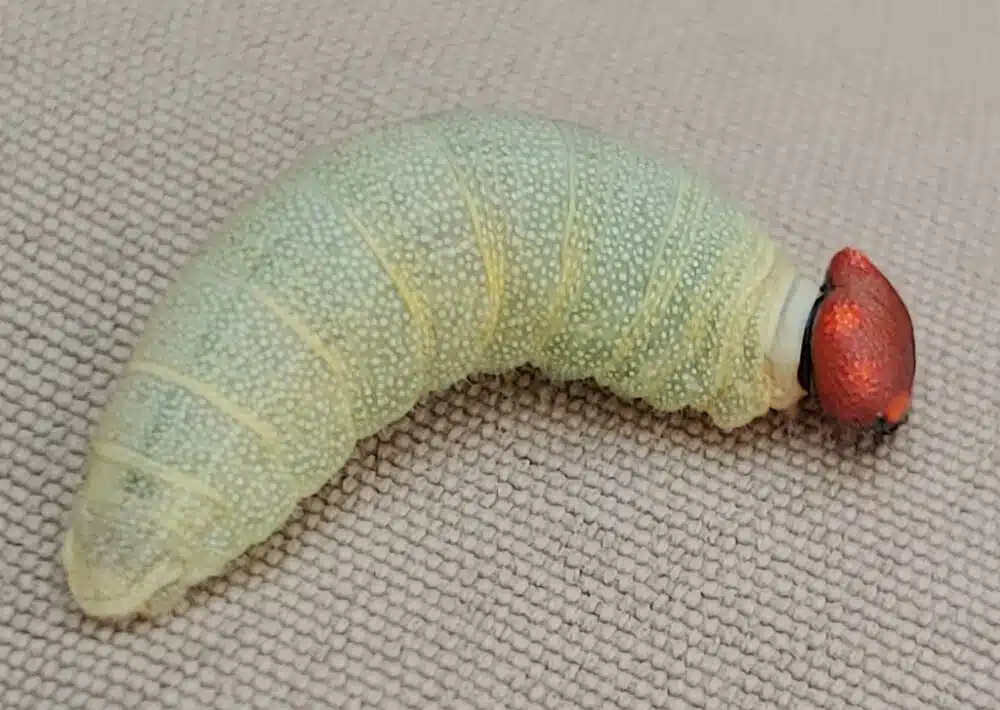
The caterpillar of Horace’s Duskywing (Erynnis horatius) has a green body and a red-brown head. This species is one of the most common when it comes to caterpillars in Texas that feed on the leaves of hardwood trees.
Horace’s Duskywing caterpillars feed on various oak tree leaves. They are known to go for red and white oak tree leaves which they rarely majorly impact.
Only eating the edges of the leaves and a small number of leaves over their larval stage, these caterpillars cannot damage oak trees.
They remain a caterpillar for around 1 week which means they only get to eat the edges of a few leaves or even one single leaf with minimum impact on the tree.
The caterpillar has no color that resembles the adult moth which is brown and dark brown as opposed to green. Only the head of the caterpillar turns brown in the last instar.
36. Fall Webworm
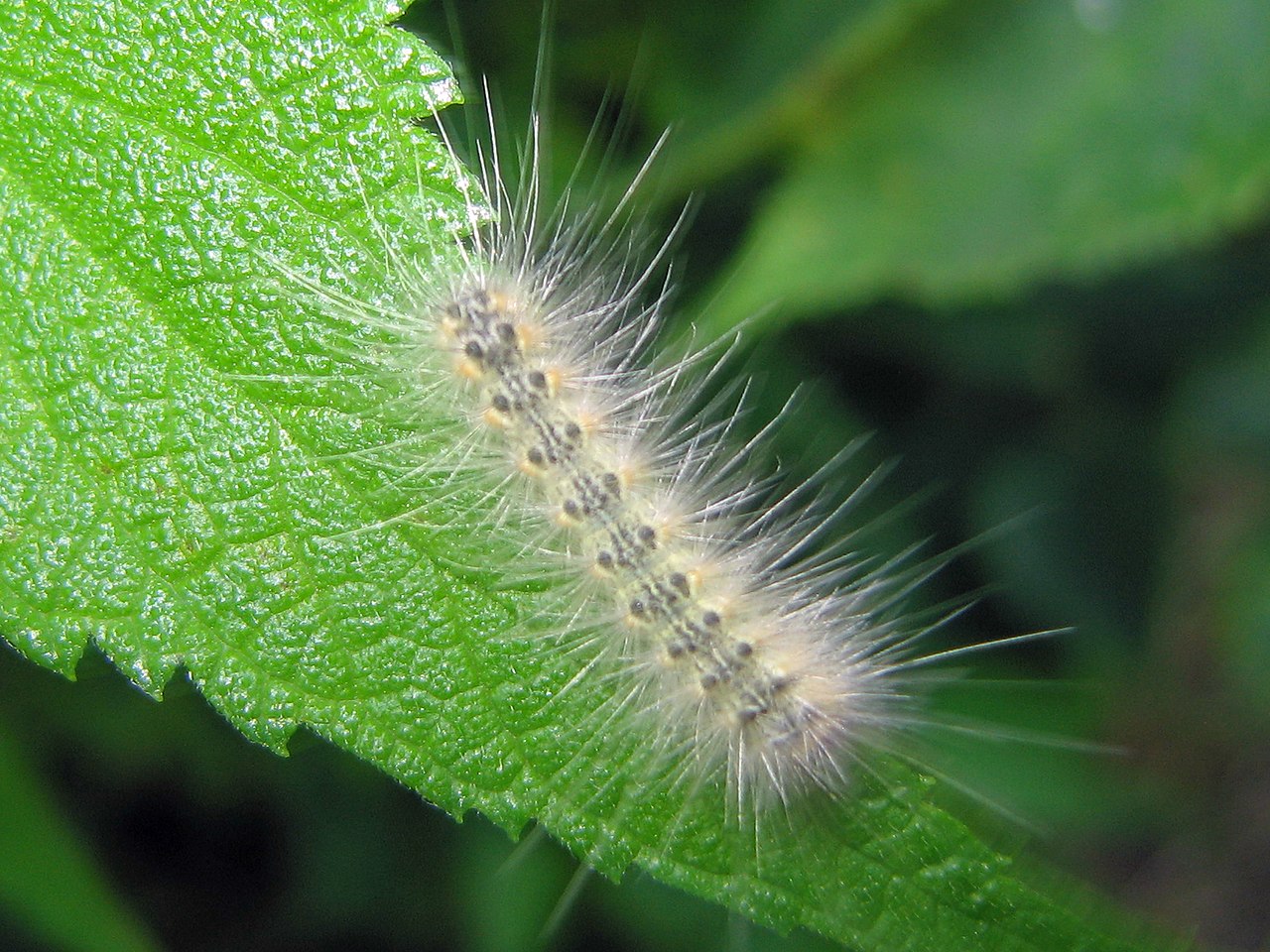
The Fall Webworm (Hyphantria cunea) is one of the species that has a long instar period. It’s also among the few Texas caterpillars that build tents or silk-like protective structures to ward off predators such as spiders.
These tend to cover entire branches of elm trees and other trees these caterpillars feed on.
Caterpillars develop in these tents where they start to eat the leaves of the trees. These leaves are first consumed in small amounts.
Fall Webworms start feeding on the edges of the leaves first. They only eat entire leaves from the 3rd instar.
These caterpillars spend a very long time in a caterpillar stage, which explains why they need tent-like silk protection.
It can take up to 8 weeks for Fall Webworms to go through all of their instars.
37. Southern Flannel Moth Caterpillar

Southern Flannel Moth caterpillars (Megalopyge opercularis) are the most common hairy species in Texas.
These are among the few caterpillars which grow long hairs all across the body into their late instars.
Some data suggest the Southern Flannel Moth caterpillar goes through 5 instars while others suggest the species goes through 6 instars.
There’s a clear indication of the appearance of the species, on the other hand.
Caterpillars of this genus are born yellow. They have a lemon yellow color which darkens as the caterpillar progresses through the instars.
It eventually starts growing gray-brown hairs. These hairs are so long that they eventually cover the entire body.
No yellow part of the caterpillar remains visible towards its final instars.
Growing hairs is an adaptation to avoid predation as this species can be exposed to certain types of birds that also visit elm trees they grow on for food.
38. Goatweed Leafwing Caterpillar
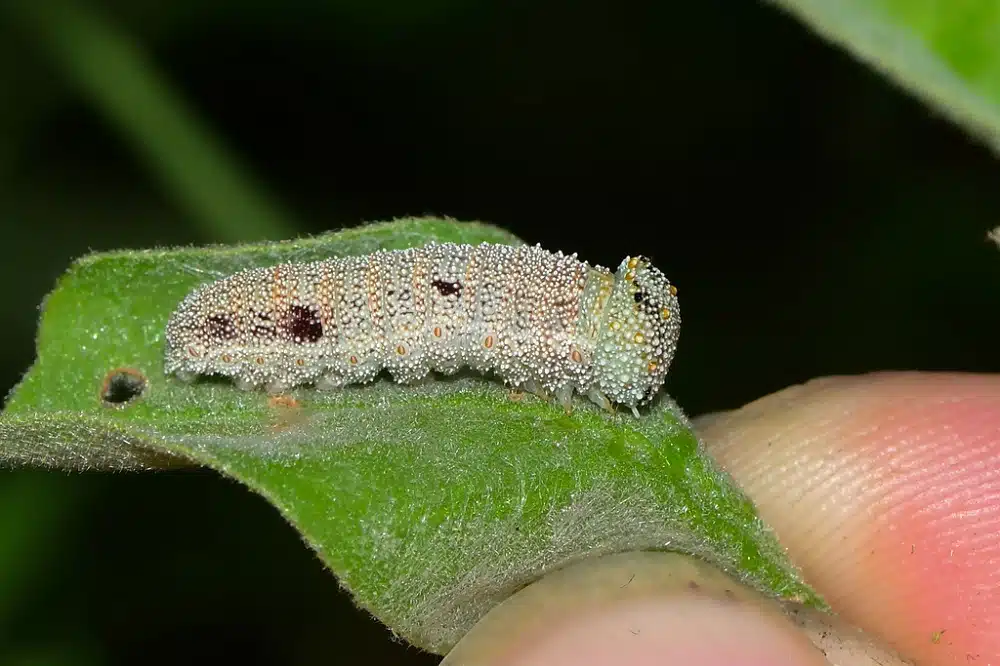
Goatweed Leafwing caterpillars (Anaea andria) constantly eat and grow to resemble the host plant they live on.
The more they develop the more they look like the host plant.
Many caterpillars adopt this camouflaging technique but Goatweed Leafwing caterpillars might be overlooked completely when on their host plant.
Most caterpillars of this genus grow on silver croton hosts.
This is a species found in many Southern states.
The caterpillar goes through the first instars essentially becoming gray. Its body is covered is mall tubercles.
Such small tubercles have the purpose of making its body look uneven and essentially mimic the texture of the host plant stem.
The final result is a caterpillar dominated by gray tubercles both on the body and on the head.
39. Southern Dogface Caterpillar
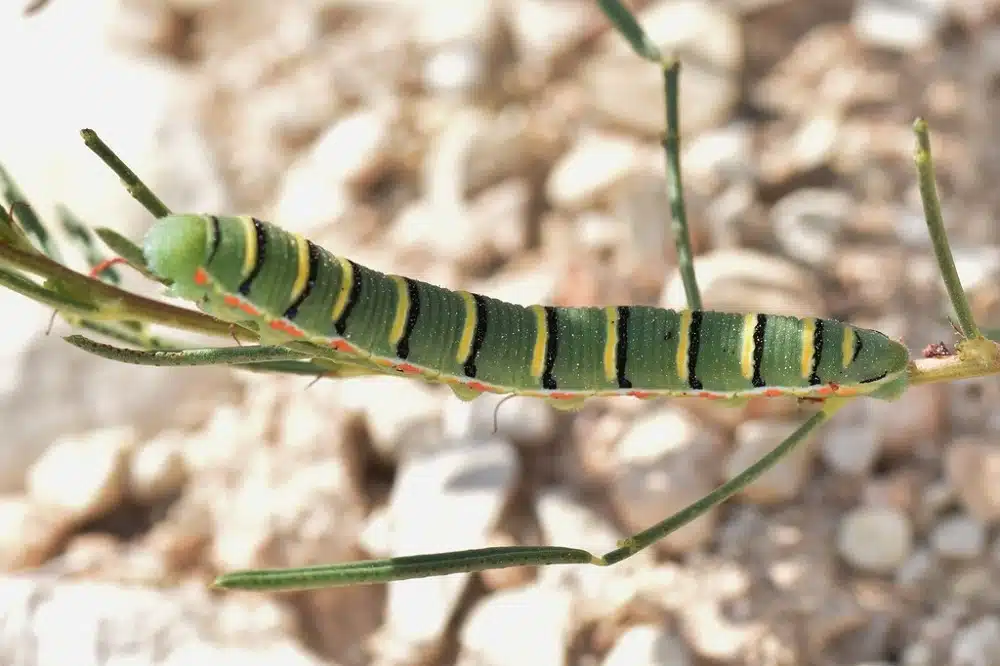
The Southern Dogface caterpillar (Zerene cesonia) is one of the common species with a considerable impact on alfalfa.
Its impact on alfalfa is large since both the caterpillar and the adult use it for food. Adults consume alfalfa nectar while caterpillars mostly eat their leaves and stems.
This species of caterpillar mimics the stems of alfalfa sitting right above the leaves where it can easily chew on multiple leaves.
It has a dark green body that resembles the color of the dark green alfalfa leaves.
Black and yellow stripes are also seen across its dorsum. It’s the yellow stripes that make it stand out and lose camouflage but gain the appearance of a possibly-toxic species.
As a result, birds often move along ensuring the species can further develop into a large yellow moth.
40. Fall Armyworm
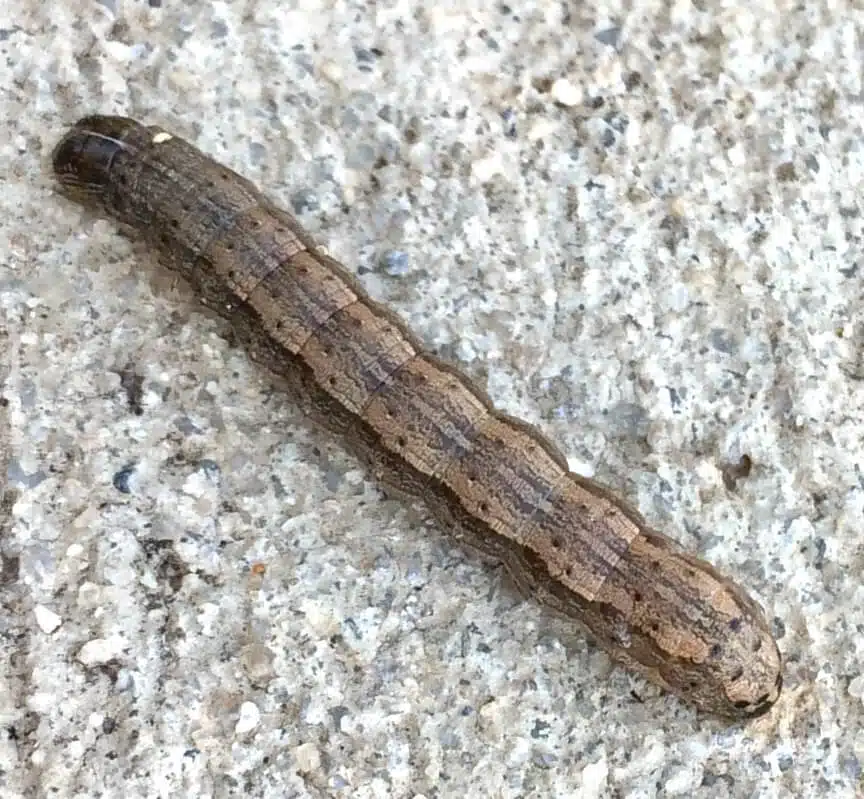
Fall Armyworms Moth (Spodoptera frugiperda) are some of the most feared moth species in the United States. This moth species is one of the most prominent pests of corn.
In some states, this moth is the most important pest of corn by its numbers.
As a result, its caterpillar is as feared as the adult moth itself.
Caterpillars of the species feed on corn, just as adults. Their impact can be wide, causing important economic losses.
The caterpillar hides in the long wide leaves of corn and goes unnoticed many times.
Insecticides are used to control its population as well as crop rotation techniques which ensure emerging caterpillars cannot feed on corn the following year.
You can recognize this species by its brown and gray long body. Caterpillars of this genus also exhibit dark brown spots which resemble the final color of the brown adult Fall Armyworm moth.
41. Ailanthus Webworm
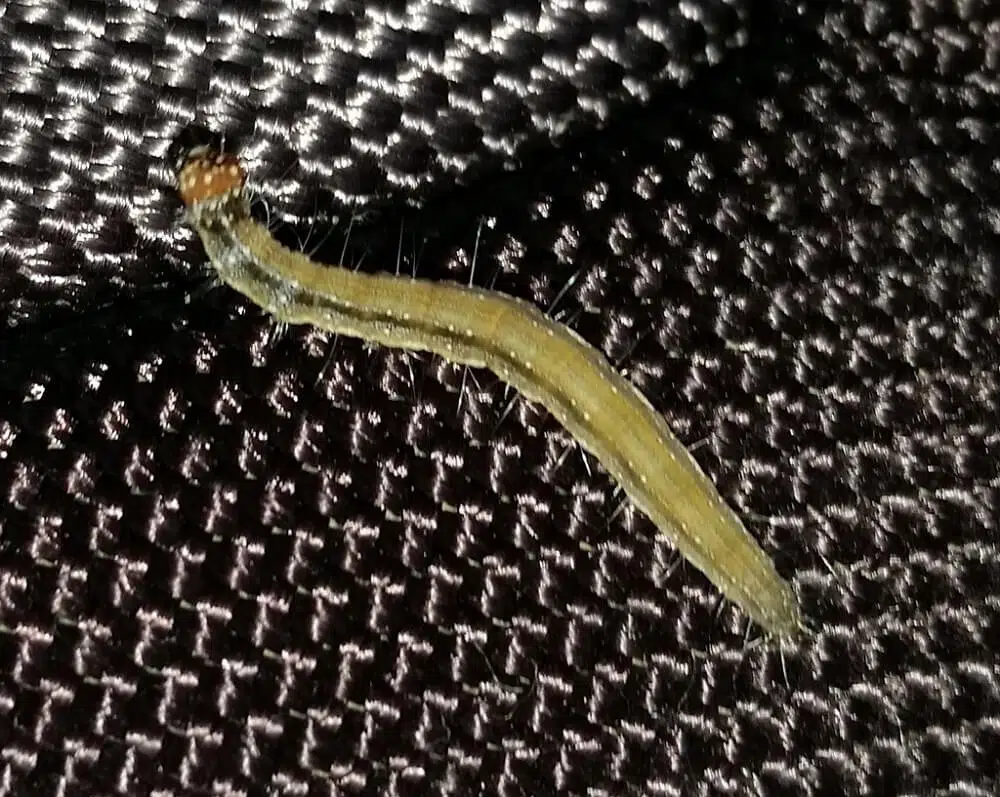
The brown to black Ailanthus Webworm (Atteva aurea) is another species with the potential to become a feared pest of trees.
This species has adapted to a range of native and imported trees for the foliage.
Caterpillars of Ailanthus Webworm come from Southern Florida. They have expanded their territory into Texas where they feed on a series of trees from the Paradise tree genus.
They have also adapted to imported species of trees with soft leaves such as the Tree of Heaven which they can invade in high numbers.
The caterpillar alone might not kill any of these trees. However, it can kill these trees whenever other invasive species use them for sap.
42. Ceraunus Blue Caterpillar
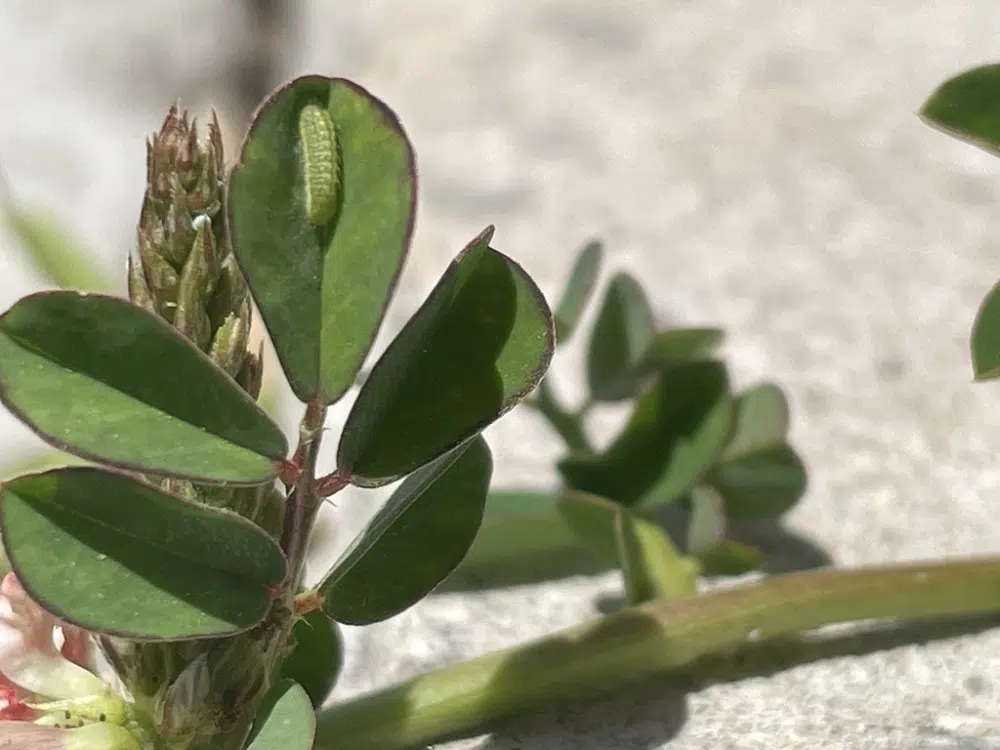
Ceraunus Blue caterpillars (Hemiargus ceraunus) are a rare type of species in Texas that mimic slugs.
This comes to its advantage as many predators such as birds know slugs have bad taste. The popular bad taste and sometimes toxic nature of slugs are what make this species safe from predatory attacks.
It can be found on host plants in the pea family. Rosary and partridge pea are some of the most common types of pea plants on which these caterpillars are found on.
Together with other pests, they can dry and kill these pea species.
Ceraunus Blue Caterpillars are most likely to be predated in their first and second instar.
The caterpillar is green at this stage without any dots or stripes that would indicate a potentially-toxic species to predators.
In time, this species turns tan and brown resembling slugs.
The caterpillars now face a reduced risk of predation once brown.
As a result, this capacity to keep many predators away allows the Ceraunus Blue caterpillar to multiply a few times per year.
Like many caterpillars in multiple broads per year, the Ceraunus Blue caterpillar begins mating as soon as it emerges as an adult tropical butterfly.
Females fly low looking for peas and other vegetables to lay eggs on for the next generation of caterpillars.